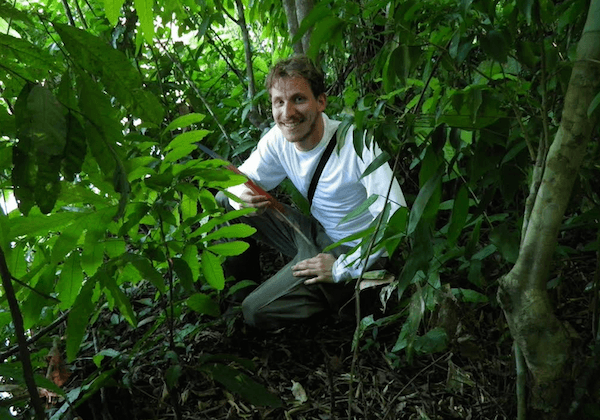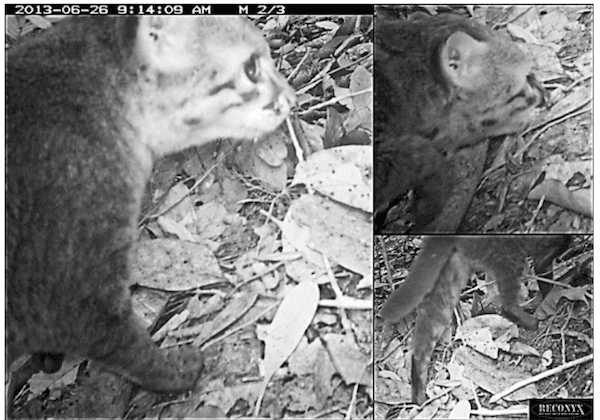Olah was already studying the genetics of scarlet macaws (Ara macao) in a remote area of southeastern Peru when the Transoceanic Highway was built through the middle of his research area. He realized that the forensic genetics techniques he was using to learn more about the local macaw population might also uncover evidence of the road’s impact on the birds.
With forensic genetics, scientists search for DNA markers that are unique to specific organisms to discover links between individuals or events. For people, the FBI uses DNA markers to identify crime suspects. In conservation biology, “genetic tagging” gives researchers a non-invasive way to monitor wildlife populations.
“Given how little we know about these wonderful birds, studies on the genetic composition of these wild populations are essential steps in learning about their biology,” said Ian Tizard, a Texas A&M University professor who led a study that mapped the scarlet macaw’s genome last year. “Simply because we have lots of these birds in captivity tells us very little indeed about their real biology.”
For Olah, insights into his macaw study population were hidden in the colorful feathers the macaws left behind. The molted feathers from scarlet macaws are sources of small amounts of DNA. Olah and his colleagues extract that genetic material, and then amplify it, to find the “fingerprints” unique to an individual bird. Each DNA sample from a feather contains a genetic tag unique to the bird from which the feather came. By collecting feathers and sequencing their DNA, the researchers can build a picture of individual birds’ movements through their habitat.
Sequences of DNA act as codes that create the biological blueprints of most organisms (viruses and some bacteria use a different type of molecule, called RNA). But some DNA doesn’t seem to code for anything specific; instead, it contains short sequences of repeated code called STRs. These STRs are the portions of DNA that are specific to only one individual, and they’re the key to genetic tagging. Once geneticists find these spots, that’s where they look when they want to compare the DNA of different individuals. For determining the identities of people, the FBI uses 13 STRs. In the scarlet macaws, Olah has found 39. Now, Olah is refining that number down to the fewest STRs needed to identify one particular bird.
By cataloging these highly specific genetic markers and mapping where each feather was found, researchers can get a good idea of population size, gender distribution, and the links among related macaws – all without ever touching a bird. Olah can also “tag” macaws, and track where they travel. After he accumulates a baseline of data regarding the size, range, and diversity of macaw populations, then he can track changes that occur if the birds’ habitat is disturbed.
“Once we put the samples’ tags on the map of our study site, we expect to see different patterns in migration,” Olah said.
Finding samples from the same individuals or families in the landscape can tell researchers where these birds move, how far from their nests they fly, or where evidence of their presence can’t be found.
“If there are human impacts on their dispersal pattern, we should be able to detect that [by] comparing these genetic patterns (distances) to the locations of cities, roads, or other human activities,” he added.
When a population is divided by a barrier – such as a road – the individuals from the two sides may become isolated from each other. The flow of genes may become restricted in these subpopulations, which can lead to reductions in their genetic diversity. With less diversity, a population is more at risk of “inbreeding depression,” in which harmful traits become more likely to arise, making the population more vulnerable to disease and extinction.
“If the highway is indeed a barrier for macaws, it raises long-term concerns about the population’s genetics and conservation consequences,” Olah said.
Currently, scarlet macaws are listed as Least Concern by the IUCN. However, according to Don Brightsmith, director of The Tambopata Macaw Project, a research center located in the tropical lowland rainforest of Peru that hosts scientists such as Olah, macaws are experiencing a general decline in most of the Americas. The long-lived birds hatch several chicks each year. But nesting pairs pick only one chick to feed and nurture to fledging age, letting the other hatchlings die. This single-offspring strategy makes it hard for macaw populations to grow in the face of overhunting for food and the pet trade, or road construction that cuts down the old growth trees the birds need for nesting hollows.
Olah’s three-year study is focused on the area around Puerto Maldonado, the capital of the Madre de Dios Region in the Peruvian Amazon. Three large protected areas, the Tambopata National Reserve, Bahuaja-Sonene National Park, and the Los Amigos Conservation Concession, as well as eight rivers, are included in his research area.
It turns out that southeastern Peru may the best place possible to collect feathers for genetic tagging studies. The location has the largest-known concentration of clay licks anywhere in the world, with more than 150 along the 1,760-kilometer (1,100-mile) river system. The macaws visit these sites on a regular basis – daily, weekly, or seasonally – to lick up gobs of sediment. The clay contains high amounts of sodium, leading some scientists to hypothesize the birds are replenishing sodium missing from their diet, while others suggest that the clay helps remove toxins that the birds accumulate through their diets. Regardless of the reason, when macaws flock together at the clay licks they leave behind plenty of feathers for Olah and his colleagues to collect.
The feathers Olah is using in his research come from around 14 of the clay-licks. He visits one or to two daily, resampling those sites every second week.
“By looking only at samples of one clay-lick during different times we can see if the composition of birds are changing over the course of the study, or if the birds are migrating from one site to another,” Olah said.
Olah described the genetic tagging method as being similar to counting automobile license plates in a small town.
“It won’t be too long before you come across the same license plates,” he said. “Based on how frequently you come across the same ones, you can estimate the total size of the license plate ‘population’ by way of statistics.”
The use of genetic tagging for studying animal populations isn’t new. Researchers first used the method more than a decade ago to understand how bush rat populations recovered after sudden drops in their numbers. More recently, scientists used DNA from elephant scat to track down ivory poachers.
Once Olah validates the tagging technique on scarlet macaws and whittles down the 39 STRs he currently uses, he wants to add these markers to the genetic tool kit for conservation of other endangered parrots. He’s also working in collaboration with Brightsmith on the Tambopata Macaw Project. Each year, they capture adult macaws for satellite tracking with radio collars. So far they’ve tracked about 14 birds from three different macaw species.
“The two techniques are totally opposite,” Brightsmith said. “With satellite collars, we’re working really hard to capture one bird and watch where it goes. But Olah is looking at cast-off feathers from lots of individuals and trying to catch a few of those doing interesting things. The information is complementary.”
Since the big road has been built, it continues to bring more human and land-clearing traffic into the heart of the rainforest. Although the road doesn’t physically stop birds from flying over it, the noise and habitat changes that come with it may be acting as a barrier to normal movement patterns. It will take several generations of birds before any bottlenecks in gene flow can be detected. But by collecting feather samples at clay licks on both sides of the highway, Olah thinks he can find genetic clues from the individual feathers. He’s set up pairs of sample sites for comparison, one on each side of the highway. With regular re-sampling from these sites, Olah can map out whether birds continue to move across the road or start limiting their movement around the landscape – long before changes show up in their DNA.
As Olah refines his work, he’s also planning to test the tagging technique on macaws in the nearby Candamo Valley. This area is bordered by the foothills of the Andes and is considered a stronghold of biodiversity by virtue of its isolation. Oil companies recently found a huge hydrocarbon deposit there and are pressuring the Peruvian government to allow full-time drilling, an activity certain to take a toll on wildlife that make their home in the valley.
Right now the area is still protected as a Peruvian National Park, a status that means no human activity can take place there – even scientific studies – without special permits. But that may not last forever. Olah has already gathered feathers from scarlet macaws in the region to search for evidence that Candamo Valley is a key location for these birds. If the genetic tagging proves useful as a conservation tool for these birds, Olah wants to expand its use to other macaw species.
“Our samples from Candamo will provide a strong scientific basis for identifying the importance of the valley, and will be extremely important in [making] recommendations for maintaining the protected status of this biodiversity hotspot,” Olah said.
This article was originally written and published by Elizabeth Devitt, a contributing writer for news. mongabay.com. For the original story and more information, please click HERE.

